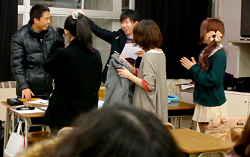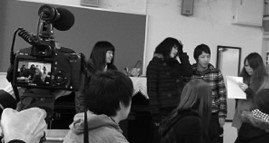References
Abercrombie, M. L. (1959). The anatomy of judgment. New York, NY: Basic Books (in Bruffee, 1999).
Aronson, E. (2008). The social animal (10 ed.). New York, NY, USA: Worth Publishers.
Barkley, E. F., Cross, P. K., & Major, C. H. (2005). Collaborative learning techniques: A handbook for college faculty. San Francisco, CA: Jossey-Bass.
Bertalanffy, L. V. (1969). General system theory. New York: George Braziller, Inc.
Bruffee, K. A. (1999). Collaborative learning: Higher education, interdependence, and the authority of knowledge (Second ed.). Baltimore, MD: The Johns Hopkins University Press.
Calvin, W. H. (1996). How brains think. New York, NY: Basic Books.
Duncan, B. (2013). Assessing the viability of team learning with remedial students in a lecture-based Japanese higher education culture. Ann Arbor, MI: ProQuest LLC, Fielding Graduate University. Retrieved from https://search.proquest.com/docview/1352039981
Fink, L. D. (2004). Beyond small groups: Harnessing the extraordinary power of learning teams. In L. K. Michaelsen, A. B. Knight, & L. D. Fink (Eds.), Team-based learning: A transformative use of small groups in college teaching (pp. 3-26). Sterling, VA: Stylus Publishing, LLC.
Fiske, S. T. (2010). Social beings: Core motives in social psychology (2nd ed.). Hoboken, NJ: John Wiley & Sons, Inc.
Hackman, R. J. (1992). Group influences on individuals in organizations. In D. M. Dunnette, & L. M. Hough (Eds.), Handbook of industrial and organizational psychology (pp. 199-267). Palo Alto, CA: Consulting Psychologists Press.
Hughes, R. L., Ginnett, R. C., & Curphy, G. J. (2005). Leadership: Enhancing the lessons of experience (5th ed.). New York: McGraw-Hill.
Imafuku, R., Kurata, N., Kataoka, R., & Mayahara, M. (2010, December 3). First-year students' learning experience of problem-based learning tutorials in Japanese higher education. Enhancing learning experiences in higher education international conference. Hong Kong, China: University of Hong Kong.
Jex, S. M. (2002). Organizational psychology: A scientist-practitioner approach. New York: John Wiley & Sons.
Kenrick, D. T., Neuberg, S. L., & Cialdini, R. B. (2007). Social psychology: Goals in interaction (4th ed.). New York, NY: Allyn and Bacon.
Kreitner, R., & Kinicki, A. (2008). Organizational behavior (8th ed.). New York, NY: McGraw-Hill/Irwin,.
Maslow, A. H. (1987). Motivation and personality (3rd ed. ed.). (R. Frager, J. Fadiman, C. McReynolds, & R. Cox, Eds.) New York: Addison Wesley Longman, Inc.
Saito, I., Kogo, M., Sasaki, K., Sato, H., Kiuchi, Y., & Yamamoto, T. (2007). Introducing novel learning methods to a pharmacy school in Japan: A preliminary analysis. Pharmacy Education, 7(2), 103-108.
Shuji, S. (1999). Cooperative learning in Japan: History and present situation of research and implementation. In D. Kluge, S. McGuire, D. Johnson, & R. Johnson (Eds.), JALT applied materials: Cooperative learning (pp. 38-49). Tokyo, Japan: Japan Association for Language Teaching.
Treisman, U. (1985). A study of mathematics performance of black student-athletes. The University of California, Berkeley (Cooperative learning). Berkeley, CA: the University of California, Retrieved February 2, 2011, from Dissertations & Theses: Full Text.
Treisman, U. (1992). Studying students studying calculus: A look at the lives of minority mathematics students. College Mathematics Journal, 23(5), 362-372.





![Your brain can keep growing, adapting, and learning at any age, if you are willing to put in the effort [Image: Copilot]](/images/Images/best-years-for-adult-brain300.png)
